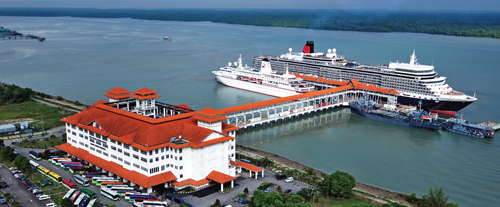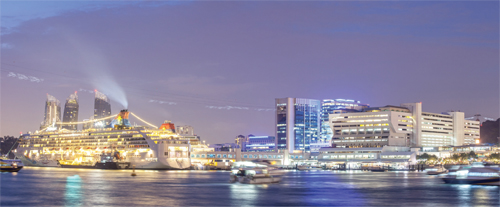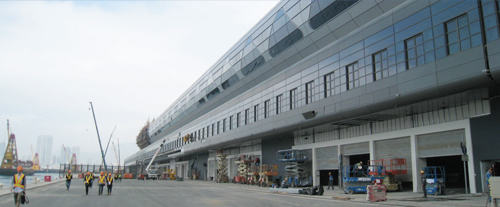Asia is the new must-stop for international cruises, but not all destinations have the necessary hardware and software. Who are the front runners and who are those that need to shape up or ship out?

Port Klang Cruise Centre
Malaysia
By S Puvaneswary
Volume Cruise passengers to Malaysia have been steadily rising in the last three years, with this year’s figure estimated to exceed half a million. In 2012, Penang handled the largest number (211,554), followed by Klang (141,266) and Malacca (54,166). This corresponds with the number of international cruise ship calls recorded by the country last year. Penang received the most calls (139), followed by Klang (98) and Malacca (37).
This year, however, Langkawi is expected to claim the third spot, beating Malacca with 59,600 passengers and 52 calls.
Port Klang Cruise Centre head of corporate communications, Ahmad Kamal Abdollah, said: “We see increasing berth bookings for the next two years by larger ships on itineraries previously undertaken by smaller counterparts.
“In East Malaysia, the opportunity to develop exotic itineraries leveraging on the locations’ pristine natural beauty and local cultural elements remains very attractive. Larger ships have also been exploring this location as part of their itineraries, previously considered mainly by smaller ships.”
Industry developments To encourage foreign cruise vessels to offer services between Malaysian shores, all cruise vessels were exempted from the cabotage policy as of March 2012.
Tourism Malaysia’s director of industry development, Saidi Bundan, explained that the policy previously only allowed vessels that had been registered in Malaysia to load and unload passengers at Malaysian ports. With this exemption, international cruise ships are now able to disembark and re-embark passengers at more than one Malaysian port.
Another encouraging development is the formation of the Malaysian Cruise Council in June 2012, whose main task is to chart the direction of the country’s cruise industry and coordinate marketing efforts to attract cruise liners.
Port authorities have also been looking into the infrastructure required at the six primary ports of Penang, Klang, Kota Kinabalu, Langkawi, Malacca and Kuching, according to Mirza Mohammad Taiyab, director-general of Tourism Malaysia.
“Efforts will be focused on identifying the improvements needed at these ports to make them more attractive as cruise destinations,” he said.
What needs to be tackled
Marketing
Lim Chee Tong, managing director, Jebsen Travel & Tours Services
“More awareness needs to be created to inform cruise lines about what the country has to offer to entice them to homeport here. For example, in Penang, cruise passengers can easily move around on their own as the port is close to the city, while its local food is great. Langkawi’s attraction is that it has free port status.”
Shore excursions
Ahmad Kamal Abdollah, head of corporate communications, Port Klang Cruise Centre
“We would like to see tour operators freshening up their product offerings with innovative shore excursions, as we anticipate increased numbers of repeat cruisers who will want to experience new things at ports they have been to before.”

Singapore Cruise Centre
Singapore
By Lee Pei Qi
Volume Larger ships were previously unable to call at Singapore because of height restrictions faced at the Singapore Cruise Centre (SCC). However, the birth of the Marina Bay Cruise Centre Singapore (MBCCS) has since allowed Singapore to cater to bigger cruise ships.
Ong Huey Hong, director, cruise, Singapore Tourism Board (STB), said: “In 2012, Singapore saw more than a threefold increase in the number of maiden calls to Singapore compared to 2011. These maiden calls include the largest ships to ever homeport in Asia.
“From 2002 to 2011, cruise passenger throughput has grown at a compounded annual growth rate of 3.6 per cent. A preliminary estimate for cruise passenger throughput in 2012 is 907,000, with 332 ship calls.”
The arrival of Voyager of the Seas last year paved the way for the newer generation of larger cruise liners to dock in Singapore, including Oasis-class ships, observed Melvin Vu, CEO of SATS-Creuers Cruise Services, operator of MBCCS.
World Express managing director, Darren Tan, agreed. “We’re seeing great diversity in the types of ships calling, with even six-star luxury cruises and mega-size cruise ships,” he said.
Industry developments Considered the cruise hub of Asia, Singapore currently has two extensive cruise centres that boast superior facilities: SCC and MBCCS, which opened last October.
Located in the heart of the city, MBCCS, which has two berths and can handle 6,800 passengers at any one time, effectively doubled Singapore’s berth capacity.
Refusing to be left behind, SCC rejuvenated its terminal at HarbourFront in southern Singapore last November, creating a 26 per cent increase in passenger operations space and enabling it to handle 4,000 passengers at any one time.
Said SCC CEO, Christina Siaw: “As a well-known and reputed marine port, Singapore is a preferred spot for homeporting because everything provided is very sophisticated.”
Recognising this, Costa Cruises opened an office in Singapore last year and, for the first time, made Singapore its homeport last November.
STB’s Ong said: “This shows that cruise lines are recognising the potential in Singapore’s cruise industry and are placing greater emphasis on Asia.”
She added that STB is also building a bigger source market, working with the Asia Cruise Association and cruise lines to raise awareness of cruise tourism.
What needs to be tackled
Port facilities
Kevin Leong, general manager, Asia Cruise Association
“There can be more CIQ and terminal operator support in Singapore – especially during the weekends when ships with more international guests do their turnarounds – more taxis for disembarking guests and more flexibility in dockage charges, especially at MBCCS.”
Complete visitor experience
Darren Tan, managing director, World Express
“There are multiple factors that affect the guest experience when passengers arrive or depart via cruise ships. You need all parties to share the same objective to deliver a great visitor experience in terms of what they see as a tourist as well as efficiency in entering and exiting the country.”
Thailand
By Xinyi Liang-Pholsena
Volume Phuket received the highest number of international cruise passengers in 2012 out of all ports of entry. It had 188,771 arrivals, although this was a dip of 22.8 per cent from 244,569 in 2011. Bangkok saw a slight hike of 3.9 per cent to 5,970 passengers in 2012 from 5,745 in 2011, while Laem Chabang recorded robust growth of 34.5 per cent from 43,324 passengers in 2011 to 58,253 in 2012.
Cruises entering Thai shores are bulking up in size and quality, noted Regale International Travel general manager, Sukanya Rattanavadee. “Voyager of the Seas and Costa Atlanticaare also sailing to Thailand since the ships started homeporting in Singapore (in 2012 and 2013 respectively), as well as Queen Mary 2.”
New luxury vessels include the 112-pax SeaDream II, which will sail to Phuket during her inaugural Asian season in late 2013, while the 1,060-pax Ocean Dream launched her maiden Pattaya-Koh Samui-Sihanoukville cruise in the Gulf of Thailand from Laem Chabang last August.
Said Massy Mittakarin, general manager of Tour East Thailand: “With more cruise liners including Thailand in their itineraries, I expect inbound cruise demand to continue growing.”
Industry developments Rising demand, however, has not been met by dedicated cruise port development, say industry stakeholders.
Tourism Authority of Thailand (TAT), governor, Suraphon Svetasreni, said: “We recognise cruise travellers as a high-end market group with high spending power that can generate more income for the country. However, in terms of infrastructure, this requires a large amount of investment and cooperation from different government agencies; thus, this has resulted in the slowness of the (development) of required infrastructure.”
The Thai government should invest in a dedicated cruise terminal if it doesn’t want the country to lag behind, urged Regale International Travel’s Sukanya. “Singapore already has a new cruise centre while Hong Kong is adding the Kai Tak Cruise Terminal soon. Right now, the Laem Chabang deep-sea port is intensively used for cargo, while most cruise ships docking at Phuket port still need tenders,” she said.
What needs to be tackled
Port facilities
Suraphon Svetasreni, governor, Tourism Authority of Thailand
“We need to offer a good quality product including attractions, facilities and services that meet international standards. Facilitation of immigration procedures and transportation is also needed.
Tobias Fischer, business development director, Go Vacation Thailand
“Authorities should attend more cruise trade shows and invest in port infrastructure for commercial development. Laem Chabang also does not have enough tourist facilities even though it is large enough to handle big ships and is used as the main gateway to Bangkok.”
Indonesia
By Mimi Hudoyo
Volume The modernisation of ports across Asia has had a spillover effect on Indonesia, as the country is expecting a 54 per cent jump in cruise calls this year.
Some 308 calls with 147,134 passengers are scheduled, up from 199 calls and 118,834 passengers in 2012 and 176 calls with 112,882 passengers in 2011. This looks set to further increase in 2014, with 320 calls and 200,000 passengers planned.
Some of the new ships calling at Indonesia this year are Aegean Odyssey (378 passengers) and Pacific Venus (846 passengers), both arriving in Bali. Artania, on the other hand, visited Semarang with 1,200 passengers.
“Cruise lines do not only see Asia, including Indonesia, as a destination but also a market,” said Indonesia’s Ministry of Tourism and Creative Economy director of MICE and special interest marketing, Rizki Handayani.
She added that the port developments in Asia, such as in Singapore, China and South Korea, have allowed more cruise lines to deploy ships and develop itineraries in the region, opening up opportunities for Indonesia.
A greater number of expedition ships are also coming, noted Destination Asia Indonesia managing director, Sediya Yasa. They include Orion and Clipper Odyssey.
“Being small ships, they can cruise to places like West Papua, East and West Nusa Tenggara and Kalimantan areas, (which have exotic nature and culture).”
Industry developments Cruising is one of the special interest segments the Ministry of Tourism and Creative Economy is currently focusing on. It is working with the Ministry of Transportation and port authorities to improve facilities and services, while undertaking cruise promotions on the international stage.
Most of the cruise interest still centres on Bali, although Benoa Harbour is hampered by the fact that it is still unable to accommodate large ships carrying more than 2,000 passengers. One of the priorities is for Bali to be able to cater to turnarounds within the next few years.
Benoa’s channel is now 10m deep, but it needs to be at least 14m deep and 150m wide. According to Rizki, Indonesia’s transport ministry has committed to setting aside money to deepen the channel to 12m this year and 14m by 2014.
Meanwhile, port developments are also under way in other parts of Indonesia such as Semarang and Lombok, enabling big ships to berth, while a second port in Bali is being planned in Tanah Ampo.
What needs to be tackled
Cruise agents
Rizki Handayani, director of MICE and special interest marketing, Ministry of Tourism and Creative Economy
“We need to have more cruise agents in Indonesia in order to develop a wider variety of shore excursions. There are only about six active ones. It may take a lot of investment and effort to handle and win the trust of cruise lines initially, but it is good business.”
Land attractions
Sediya Yasa, managing director, Destination Asia Indonesia
“Developing new destinations is not only about building ports, but also attractions. Semarang Port, for example, has the Borobudur Temple, and Probolinggo in East Java, Mount Bromo. What else do we have? We need to find new highlights.”

Kai Tak Cruise Terminal
Hong Kong
By Prudence Lui
Volume Hong Kong has not seen tremendous growth in its number of ship calls and passenger throughput over the last three years, with calls totalling 2,166 in 2012, 2,125 in 2011 and 2,111 in 2010. This figure, however, includes cruises without destination.
Cruises with Hong Kong as a destination, including using it as a transit or homeport, accounted for 98 calls in 2012, 104 in 2011 and 120 in 2010.
Correspondingly, passenger numbers also did not shift much, with 1.4 million passengers arriving in Hong Kong last year, compared to 1.6 million in 2011 and 1.5 million in 2010.
Sightseers (HK) managing director, Linda Yuen, said: “In the last few years, there weren’t many big changes, except more travel consultants venturing into selling cruises. Cruise lines like Costa Cruises are also now deploying bigger vessels to serve the market.”
Industry developments Hong Kong’s capacity limitations will be alleviated in June. Said a Tourism Commission spokesperson: “The commissioning of the Kai Tak Cruise Terminal, which will be able to accommodate the largest cruise ships up to gross tonnage of 220,000 tonnes, will solve this problem. Bigger ships will no longer be required to make alternative berthing arrangements.”
She added that Hong Kong Tourism Board had organised the inaugural Seatrade Hong Kong Cruise Forum in January to encourage itinerary development and regional cooperation.
“Together with the well-established Ocean Terminal in Tsim Sha Tsui, the cruise berthing capacity of Hong Kong will be greatly enhanced, welcoming all types of cruise ships from the world,” said the spokesperson.
Thrice the size of the existing Ocean Terminal, Kai Tak’s second berth will be ready in mid-2014. At least 16 ships are scheduled to arrive up until April 23, 2014, such as Diamond Princess and Celebrity Millennium.
What needs to be tackled
Recognition as a source market
Lanny Leung, CEO, Wing On Travel Service
“It would be a big help if cruise operators could make Hong Kong their homeport or put it in their itineraries so travellers could board here instead of flying overseas. Given the rising demand for cruises, especially from China and Hong Kong, the segment demonstrates positive growth.”
Visa facilitation
Jeff Bent, director – cruise, rail and business development, Worldwide Flight Services
“We hope that NTOs can help to persuade their governments to either waive visa restrictions for cruise visitors or make visas on arrival free and quick. They should also assist cruise lines to develop regional itineraries in tandem with other NTOs.”
Philippines
By Rosa Ocampo
Volume While numbers are still small, data from the Department of Tourism shows that there are more international cruise ships calling on the Philippines.
Last year, ports received 17 cruise ships with 13,466 passengers, a leap from 11 ships with 9,770 passengers in 2011. In the first quarter of this year, 13 ships with 7,897 passengers called on Manila’s South Harbor alone.
Despite its substandard facilities, Manila’s South Harbour is the top port in the country based on number of calls. Cebu takes second place as the principal port of entry into the Visayas.
From only three ports of call in 2011 (Manila, Cebu and Puerto Princesa), this saw an increase to six (adding Cagayan, Romblon and Subic) in 2012.
Marilyn Tungia, inbound tour supervisor at Sharp Travel Services, said the trends include bigger ships coming in such as Queen Victoria with 1,800 passengers last month, ships calling with more frequency, and the inclusion of new destinations such as the Hundred Islands in Pangasinan, La Union.
Industry developments Ironically, for a country that has thousands of islands, the Philippines lags in developing its cruise facilities.
Even the country’s main international port in Manila has no dedicated cruise facilities as it was designed for handling cargo. There have been plans to gradually shift cargo operations to Batangas and Subic, but there has not been progress.
International cruise ships call at Pier 15 at the Manila South Harbour, which is also shared by cargo ships, visiting warships and inter-island vessels. Pier 15 can accommodate five regular ships at one time and has a passenger terminal for up to 2,000 passengers.
As it is known to be dirty, dusty and unsightly, it has become an embarrassment for the travel trade who are clamouring for its overhaul.
By infrastructure, the Subic Bay Freeport Zone is the best in the country and the only one that meets the standards of many cruise lines. However, Subic’s tourist attractions need more packaging and promotion.
Subic Bay Metropolitan Authority chairman and administrator, Roberto Garcia, said an integrated world-class family resort was on the cards for Subic, which would include a cruise ship passenger terminal in the area of the unused international airport. He added that the project would commence as soon as the feasibility study has been approved by the Philippine president.
What needs to be tackled
Port facilities
Carla Mariano, Blue Horizons Travel & Tours manager – groups, MICE and special projects
“We would like the ports to be kept clean, with well-maintained restrooms. There should also be a welcome ceremony for ships in the form of musical entertainment and activities showcasing what the local destination is all about.”
Shore excursions
Maria Corazon Jorda-Apo, group head, North America and Asia-Pacific, Department of Tourism (DoT)
“The DoT is encouraging inbound tour operators to offer shore excursions that are interactive, educational, experiential and enjoyable.”




















